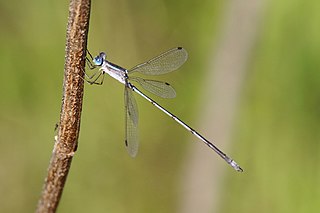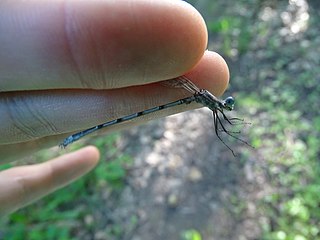
Lestes alacer, the plateau spreadwing, is a species of spreadwing in the damselfly family Lestidae. It is found in Central America and North America.
Lestes auripennis is a species of spreadwing in the damselfly family Lestidae.

Lestes australis, the southern spreadwing, is a species of spreadwing in the damselfly family Lestidae. It is found in North America.
Lestes curvatus is a species of spreadwing in the damselfly family Lestidae.
Lestes debellardi is a species of spreadwing in the damselfly family Lestidae. It is found in South America.
Lestes dichrostigma is a species of spreadwing in the damselfly family Lestidae. It is found in South America.

Lestes disjunctus, the northern spreadwing, is a species of spreadwing in the damselfly family Lestidae. It is found in North America.
Lestes auritus is a species of spreadwing in the damselfly family Lestidae. It is found in South America.

Lestes eurinus, the amber-winged spreadwing, is a species of spreadwing in the damselfly family Lestidae. It is found in eastern North America.

Lestes forficula, the rainpool spreadwing, is a species of spreadwing in the damselfly family Lestidae. It is found in the Caribbean Sea, Central America, North America, and South America.
Lestes helix is a species of spreadwing in the damselfly family Lestidae. It is found in South America.
Lestes henshawi is a species of spreadwing in the damselfly family Lestidae. It is found in Central America and South America.
Lestes paulistus is a species of spreadwing in the damselfly family Lestidae. It is found in South America.
Lestes spumarius, the Antillean spreadwing, is a species of spreadwing in the damselfly family Lestidae. It is found in the Caribbean Sea and North America.

Lestes stultus, the black spreadwing, is a species of spreadwing in the damselfly family Lestidae. It is found in North America.

Lestes vidua, the Carolina spreadwing, is a species of spreadwing in the damselfly family Lestidae. It is found in North America.

Lestes tenuatus, the blue-striped spreadwing, is a species of spreadwing in the damselfly family Lestidae. It is found in the Caribbean Sea, Central America, North America, and South America.
Lestes tikalus is a species of spreadwing in the damselfly family Lestidae. It is found in Central America.
Lestes undulatus is a species of spreadwing in the damselfly family Lestidae. It is found in South America.

Lestes unguiculatus, the lyre-tipped spreadwing, is a species of spreadwing in the damselfly family Lestidae. It is found in North America.










